Sintered Compact Surfaces For Building Facades
BUILDING APPLICATIONS
We have noted that the array of beneficial characteristics of sintered compact surfaces make them well-suited for a variety of building applications, both interior and exterior. Interior designers and architects are finding them ideal in many cases for new or existing interior wall and floors coverings, where durability, appearance, and cleanliness are important. In addition, those designing kitchens, bathrooms, and work counters like the product for its nonporous and hygienic qualities. There are even specialty fabricators, such as cabinetry, furniture, or modular construction companies, that are all starting to incorporate sintered compact surfaces into their line of offerings.
While interior applications are growing, it is the exterior applications on building facades that are garnering more and more attention. Using a thin panel type of material for a facade has been the basis for numerous wall assemblies, particularly those that rely on wood or steel framing for the structural support and need an exterior weathering surface. Sintered compact surfaces are ideal for this type of lightweight but durable system, coming in below 5.5 pounds per square foot for ½-inch-thick panels and easily compatible with insulated, framed wall assemblies. Further, with the growth in the need for continuous insulation in exterior wall assemblies to comply with energy codes and ASHRAE 90.1, even concrete and CMU block construction can benefit from using sintered compact surfaces. The sintered products can readily cover the face of the insulation, creating a full cladding surface, and be applicable to almost any of these types of wall construction.
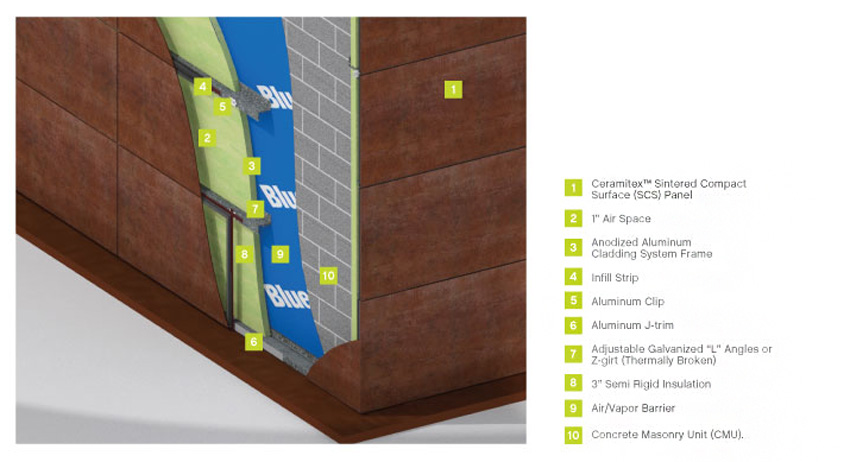
Cladding materials and panels are commonly secured to a building using vertical aluminum L or T channels secured with adjustable aluminum angle clips.
The key to successfully using a panel for the outermost surface for any exterior wall assembly option is the method of attaching or securing the panels in place. Within the general building industry, the common approach is to use an aluminum support system of vertical and/or horizontal channels or tees that are secured to the building structure with adjustable aluminum clip angles. In this way, the support system carries the weight and wind load of the cladding panels and transfers it directly to the building structure, which can readily be designed to accept it. The depth and spacing of the clips and channels can be designed to allow for continuous insulation to be installed between them and satisfy thermal envelope requirements. The channels provide vertical support using T- or L-shaped profiles depending on whether they coincide with the joints between panels or reinforce the center of the panels.
When it comes to attaching the panels to the support system, there are four common methods of attachment, and they are all appropriately being used with sintered compact surfaces. Since they each have different common applications in terms of building type and they also vary in their impact on the detailed design of the wall system, each of the four systems are discussed further as follows.
Chemically Bonded System
In the simplest form, panels can be attached using adhesives to create a chemical bond between the panel and the support system. This is most appropriately done on low-rise residential buildings where, in some cases, it may be possible to adhere the panels directly to an underlying, smooth substrate. More commonly, the panels can be adhered to the aluminum support system using an elastic chemical adhesive in the form of a tape system or applied adhesive. Such systems are commonly based on tested and certified materials and assemblies.
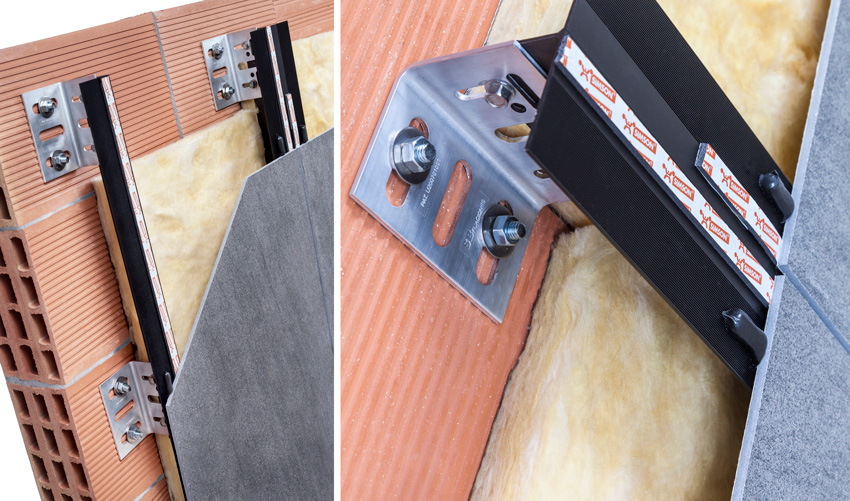
A chemically bonded system uses chemical-elastic anchoring with tapes or adhesives between the sintered compact surfaces and the support system.
There are a number of benefits of chemical-elastic anchoring, not the least of which is the completely hidden method of assembly. The anchoring is done completely on the back side of the panel, which means the panel joints are all that is seen on the face. From a performance standpoint, this type of mounting uses the continuous nature of the chemical-elastic anchoring to distribute stress evenly, preventing any concentration of stress in the adhesion surface and minimizing critical points where ruptures could begin. The flexibility of the system reduces or eliminates the transfer of vibrations between materials in contact and helps prevent failure in the connection due to fatigue. The non-conductive properties of such anchoring enables the connection of different types of materials and prevents galvanic corrosion.
Visible Mechanical Support System
In some cases, it is desirable to have a full mechanical support system that wraps over the edges of the panels with exposed clips or clamps. Such systems have been developed for sintered compact surface facades based on using visible support squares or safety clamps to which the panel edges are secured. With these support square clamps, it is possible to adjust the location of the panel and achieve proper levelling. The support square clamps are secured to the vertical sections of the support system, commonly with stainless steel screws, allowing the panels to be quickly and easily replaced if needed. To ensure the stability of the system, a line of elastic adhesive can be placed all along a vertical T-profile support. This elastic adhesive also improves the system’s reaction to wind pressure or suction and loads since the possible vibrations caused by these forces are absorbed by this adhesive.
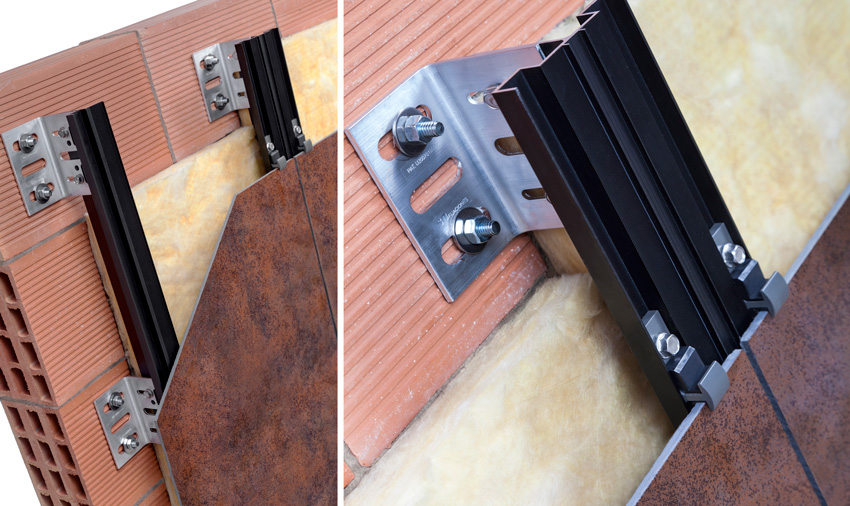
A mechanical support system with visible connectors or safety clamps can secure the edges of the panels in place and use chemical-elastic adhesive for additional security.
Non-visible Mixed Systems
There are many cases where using concealed fastening is preferred so that no clips or anchors are visible on the facade. There are several choices in this regard. The first is to use a support system designed to connect to the unexposed, rear side of a sintered compact panel. This approach is available from manufacturers based on creating angled grooves in the back side of the panel and securing horizontal aluminum channels into the grooves. In at least one case, this is achieved with a double groove at opposing 45-degree angles (like a dovetail in carpentry terms), where two aluminum profiles are inserted and fixed with structural adhesive to secure the channels to the panels. The connected channels are then secured to the aluminum support system holding up the whole facade. The panels can then hang and be levelled either to align with adjacent panels or be staggered without needing to increase the number of vertical supports. In all cases, this method of attachment allows the support system to become invisible due to the concealed fastening and aluminum members. This approach also eliminates the risk of panels separating from the structure in the event of breakage, which is why this system is considered to be among the most secure available on the market. This system also allows for easy removal and replacement of panels when necessary.
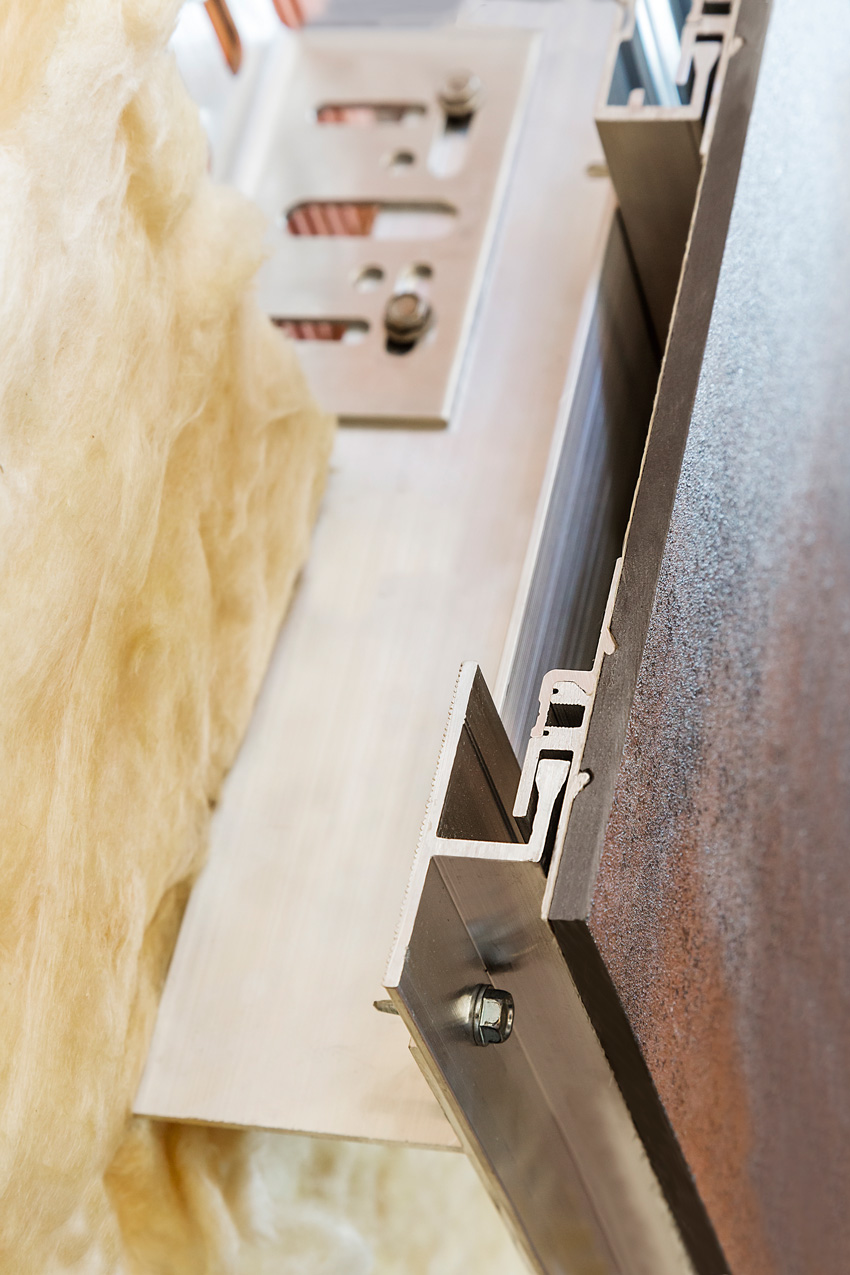
A concealed mechanical support system currently available relies on grooves being placed in the back side of sintered compact panels and aluminum support channels inserted and secured.
Another way to incorporate sintered panels into a facade with concealed mechanical attachment is to use them as spandrel panels in a curtain wall system. In this scenario, it is the curtain wall that is secured to the structure with metal clips and anchors and creates the frame for the facade materials to be inserted. In many cases, that is glass of one type or another. However, curtain walls increasingly contain insulated sections with opaque surfaces for energy code compliance, aesthetics, or both. The thin and lightweight nature of sintered compact panels allows them to be readily substituted for glass in a curtain wall system, often with the same detailing. The sintered compact panels simply fit into the curtain wall where the glass would have otherwise gone. Further, they can fully conceal and protect the area behind the panels, allowing those portions of the wall to be fully and continuously insulated.
Ventilated Rainscreen Systems
A popular building facade design approach is to use a rainscreen system, which works on the principle of separating the exterior cladding from the full wall assembly. The space between the two is intentionally designed to allow for air to enter and ventilate the wall as well as allow any water that enters to drain out of the bottom and away. The assumption is that rather than try to completely isolate water from penetrating the walls, some water or moisture will indeed get in at some point, so go ahead and plan for its escape. The idea is that the cladding is simply the first line of defense against the weather and the full air- and water-sealed wall surface behind it is the second. Any of the three sintered compact surface systems described so far can be used to create such a ventilated rainscreen on a building with very favorable results.
For tall buildings subjected to higher wind loading, ventilated rainscreens need to be looked at a bit closer. Higher wind loads mean more pressure is applied to the exterior cladding, and that can cause problems either to the cladding or the systems behind it. The solution is a pressure-equalized rainscreen, which relies on creating smaller compartments across a facade rather than one continuous ventilation cavity. These ventilation compartments respond independently to constantly changing wind pressure. When wind-driven air enters openings in the bottom of the sintered compact panels and finds no way to exit, the air pressure inside the cavity matches the wind’s pressure and “pushes back” against it, preventing wind-driven rain from entering. If a small amount of rain is driven into the cavity, the same openings allow the water to drain. Since these systems perform well under severe conditions, they can be shown to meet the approval of specific regional regulations, such as Miami/Dade County for hurricane resistance and California for seismic concerns.
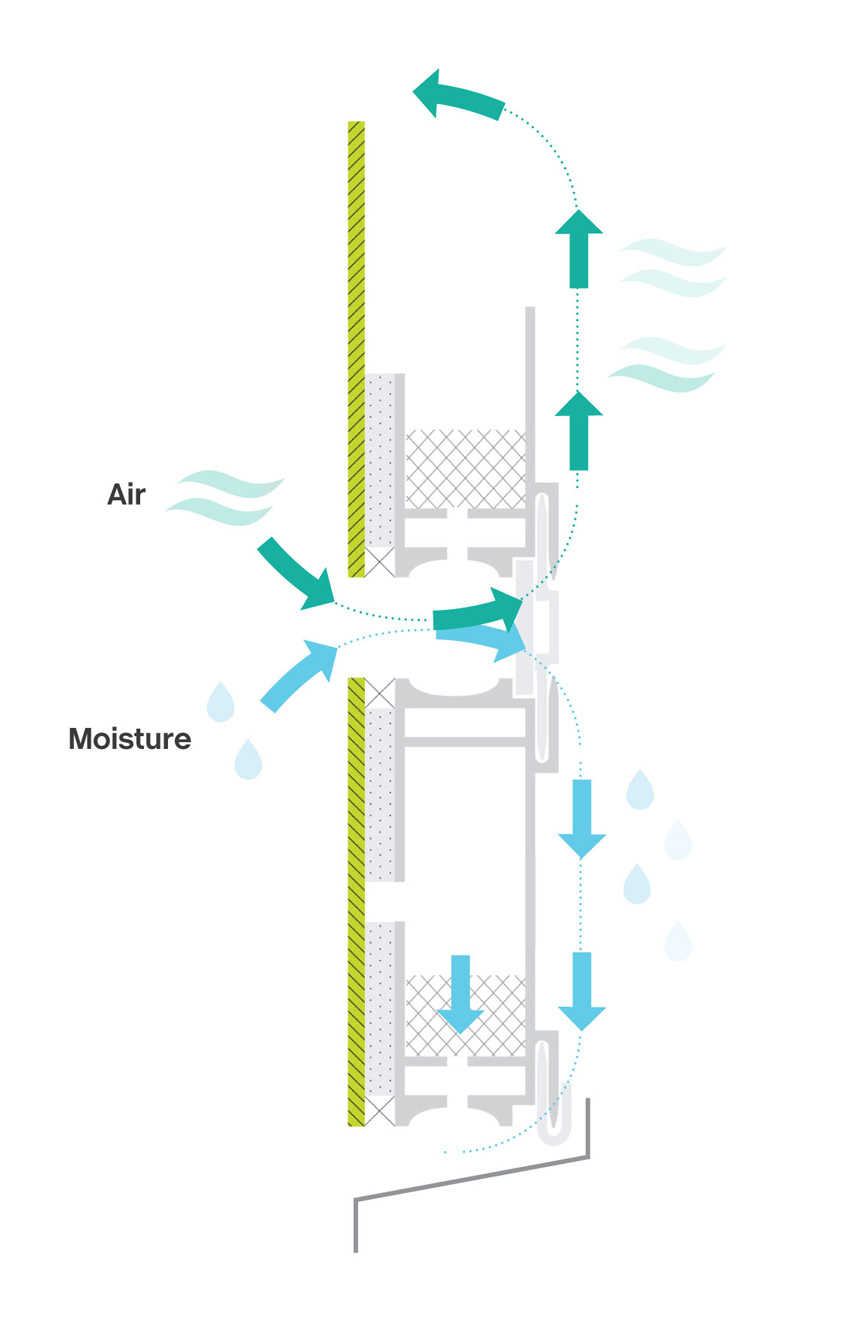
Pressure equalization in a rainscreen reduces the pressure difference across the cladding through the use of compartmentalization and back venting. Ingress of incidental water is reduced, and residual moisture is returned to the exterior at the drainage plane.
Installation
Regardless of the type of attachment system, it is important to install the support frame and the panels in accordance with manufacturers’ recommendations and instructions for specific application. In all cases, the large sizes available help reduce installation time, thus saving labor costs. Since it is a thin but durable product, it can be installed over existing surfaces, thus avoiding or reducing demolition and waste disposal activity and costs. This is readily done using one of the systems described above. Direct application onto an existing wall surface, however, will require an assessment for suitability and compatibility since some surfaces may not be appropriate. Nonetheless, as noted earlier, the very light size/weight ratio means that it can be installed on light-gauge metal framing wall systems









